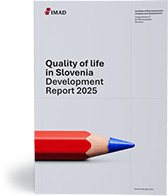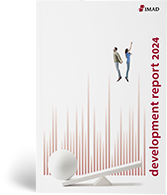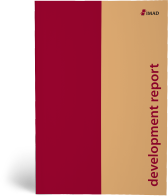Demographic changes and labour market
The growing proportion of the population aged over 65 has a significant upward effect on expenditure on pensions, health care, long-term care and other costs related to ageing. Population ageing requires, among other things, changes in the fields of social protection and employment, and appropriate policy responses in many other areas, such as adjusting the environment and services to the needs of older people. In addition to the increasing labour shortage, demographic trends also have a significant and growing impact on the labour market. The labour market plays a central role in determining economic and social progress. Its main macroeconomic indicators are employment, unemployment and wages, which are crucial for the well-being of the population.
Quality of life in Slovenia – Development Report 2025
Slovenia ranks in the top half of EU Member States on most global composite indicators of quality of life.
In the area of social development, the gap between Slovenia and the EU in terms of the population's material well-being has narrowed in recent years, alongside positive developments on the labour market. Income, wealth and wage inequality remain among the lowest in the EU, as do the AROPE…
Development Report 2024
In Slovenia, a robust post-COVID-19 economic recovery, supported by improved conditions in trading partners and substantial fiscal policy measures, was followed by a slowdown in economic growth and an increase in inflation in 2022 and 2023 in the context of the energy crisis. The impact of rising cost pressures on competitiveness and the population's lower purchasing power was cushioned by…
Wage Differences Between the Public and Private Sector and the Wage Premium
The analysis shows that, as in other countries, the average wage in the public sector in Slovenia is higher than in the private sector. In the period 2005−2022, the average wage in the public sector was about a quarter higher than the average wage in the private sector.
The difference in the average wage between the public and private sector is influenced by differences in the demographic and…
Development Report 2023
The Slovenian economy recovered quickly from the epidemic, supported by an expansionary fiscal policy. GDP per capita in purchasing power standards reached 92% of the EU average last year, the highest level ever recorded. The measures taken to support the population during the epidemic and the period of rising energy prices significantly mitigated the impact of both crises on the social and…
Development Report 2022
Slovenia’s economy saw a quick rebound in 2021 with the help of massive government measures that kept the material and financial situation of the population relatively stable. The burden of the epidemic assumed by the government was reflected in a high general government deficit and an increase in general government debt, especially in 2020. The main challenge remains to overcome the development…
Development Report 2021
The Development Report, an annual publication prepared by the Institute of Macroeconomic Analysis and Development, which monitors the realisation of the Slovenian Development Strategy 2030, brings important recommendations for development policy. Short-term priorities continue to be highly related to preventing the spread of the covid-19 epidemic and mitigating its socio-economic consequences.…
European Pillar of Social Rights, Slovenia 2000–2020
According to most European Pillar of Social Rights headline indicators (EPSR), Slovenia ranks high among EU Member States, although a more detailed analysis of EPSR principles and rights shows that challenges exist in different areas.
Development Report 2020
In March 2020, a coronavirus epidemic was declared in Slovenia, which, with its enormous negative socio-economic impact on the economic and social situation, will significantly change the baselines for the realisation of the Slovenian Development Strategy 2030 (SDS), which is monitored by the Development Report – an annual publication prepared by the Institute of Macroeconomic Analysis and…
Development Report 2019
Since 2016 Slovenia has again been narrowing its development gap with the EU average, social inclusion of the population remains relatively high, while the efficiency of energy and resource consumption has improved somewhat. These are the key findings of this year’s Development Report of the Institute of Macroeconomic Analysis and Development. In certain areas, developments deviate from the…
Development Report 2018
Back on track to convergence with more developed Member States, Slovenia has been moving towards an inclusive society in the last few years; it has also reduced pressures on the environment. In certain areas developments have deviated significantly from the principles of sustainable development and pose a risk to the achievement of the SDS’s primary objective. To achieve the SDS’s central goal, it…





